
Photo: Rick Dole/IMSA
The Twelve Hours of Sebring is one race that I look forward to every year. It’s an iconic track, with bumps that are unique and unlike any other circuit we visit in a calendar season of IMSA Sports car racing.
Due to said bumps, it also tends to be the hardest race physically on the cars and the drivers, with little to no rest, warm ambient temps, heaps of traffic, and the car needing a complete overhaul in half the run time of the Rolex 24 at Daytona.
This year was no surprise, 85-90 degrees Fahrenheit and 90 percent humidity for the bulk of our running/race.
The type of conditions that make the cockpit temp push the 130-degree range, so naturally, the prep I do as a driver will be tested.
It’s impossible to replenish the water loss via sweat from drinking, as you lose it faster than you can absorb by drinking it.
I’ve found it’s best to anticipate a “constant slope” of dehydration, so I try to slow down the effects of dehydration by being properly hydrated before hand, and handling it correctly as the water loss is ensuing.
I start by increasing my natural 100 oz of daily water intake to somewhere near the 140-150 oz range for about ten days prior to the race. This will make you best friends with your water closet initially, but your body/bladder tends to adapt over time, and the benefit here is you gain a bit more water mass which you will eventually use up during the race.
The next item on my prep list is flexibility and lower back health.
Modern GT3 cars make a significant amount of downforce, not as much as a DPi or LMP2/3, but enough that they create positive pressure over their weight, meaning there is great cornering and braking potential at higher speeds.
With that said, the extra weight that the GT3 cars retain comparatively to the prototypes also makes the leg effort on the pedal to maximize that extra grip during braking harder and heavier, thus the driver’s low back takes a pounding every brake zone of every lap.
This is why I need to prepare my muscles for the job ahead, as 3-4 hours in the high heat of repetitive, heavy motions can not only wear out muscles, but bruise them and as dehydration sets in, start cramping (which is the enemy).
For perspective, your road car has a device called a brake booster. A small (usually black) container under your hood, mounted to the firewall behind the engine, on the drivers side, which “magnifies” your leg effort on the brake pedal into fluid displacement force for the brake calipers and pads.
This is why it’s so “easy” to hit the brakes on a daily basis. These systems struggle for reliability and sensitivity of modulation at higher pressures, the kinds of brake pressures sticky Michelin slick tires, 2950-pound, 150+ mph race cars that make 3000-plus pounds of downforce create every time you squeeze that brake.
And so, race cars don’t have brake boosters as it’s a major failure point of a critical safety system.
If I had to equate the pedal effort to a common exercise that most of us have done in our lives, put three 45-pound plates on a leg press machine at a gym and Move that leg press quickly but precisely with one leg seven times per lap (2 minutes), or 210 times in every hour.
Now do that, in a 130-degree room for more than one hour at a time, and then double up on the effort and jump back to it for another two hours shortly after.
That can give an idea of the strength and endurance you need to have in your lower half ahead of a big event like the Twelve Hours of Sebring.
For us and the No. 39 CarBahn with Peregrine Racing Lamborghini Huracan GT3 Evo, If we didn’t have bad luck we’d have no luck at all.
Somewhere in the first 90 minutes while my teammate Robert Megennis started and drove our race car into the top-10, a rouge plastic bag (debris from off track) floated in front of our Lamborghini and got stuck on our radiator inlet, blocking the air to the radiator and boiling the fluid over in less than half a lap (under 60 seconds on track).
The result of this and a lengthy delay to be recovered from an overlap safe haven on track as well as refilling our coolant system for the engine meant we lost roughly 45-60 minutes during the beginning phase of the race, or in practical terms, we went many, many laps down.
It was not the way we envisioned our race going as I know it is a favorite of pretty much every person on the team.
The next best strategy for the No. 39 was to turn the race into a test session, where Corey [Lewis], Robert and myself made multiple stops in our fuel stints while we adjusted and swept settings on the car, in an effort to gain some bump compliance while simultaneously improving our car’s pitch and roll platform or support.
Those two items are exactly as you’re guessing, inverses of each other, which is why Sebring poses such a challenge for teams.
Keeping the car compliant or soft enough to absorb the bumps vertically, but stiff enough to keep the whole car even or level while it’s moving up and down during a 60-100 mph corner.
I wasn’t excited about “the hand we were dealt” this year for Sebring, but I am proud of how the team stayed mentally motivated to never stop improving, and I’m positive we gained some valuable data that will help us become faster in this new to us Lamborghini platform.


























